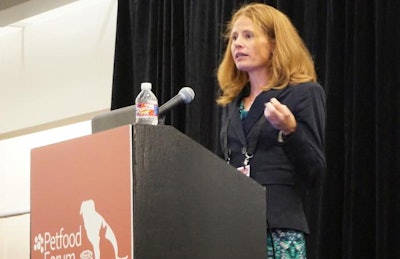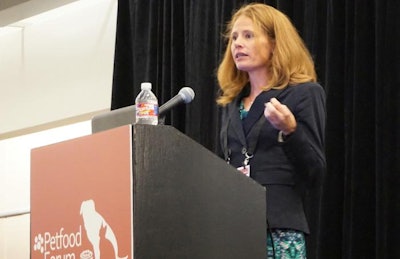
In an age where people consider their pets to be on near-equal footing as human relatives, pet food companies must be especially careful when dealing with disgruntled customers.
Dr. Melissa Brookshire, a veterinarian and founder of North River Enterprises, a consulting firm specializing in consumer support services for the pet food industry, said the industry must now more than ever prioritize developing and deploying a detailed customer service plan. Brookshire spoke on April 4 as part of Petfood Forum 2017 in Kansas City, Missouri.
Brookshire said distraught customers with sick animals will call pet food companies and claim the food is to blame for the ailment. If the disgruntled customer is not handled properly, it can do serious, lasting damage to the pet food company and its brands.

Dr. Melissa Brookshire, a veterinarian and founder of North River Enterprises, speaks about the value of strong customer support in retaining customes and preventing public image issues. Photo by Austin Alonzo.
Humanization and the (mis)information age
As Brookshire said, and pet food and other pet industry companies have been adjusting to for years, people are increasingly treating their animals as members of their family. There is an increasing willingness to pay higher prices for food that consumers view as better for their animal, as well as heightened scrutiny of pet food ingredients and the companies that manufacture and market it.
The internet and social media’s penetration of daily life means consumers are looking for information about how to raise and feed their pets online. What they find there may not necessarily be true or painting a pet food company in a positive light. Brookshire said this means pet food companies need to take a more active role in setting the agenda surrounding their products online by providing truthful information about their companies and food, as well as guides on proper care and diets for domestic animals.
The proliferation of information surrounding pets and pet ownership online carries a considerable risk for pet food companies because users can post false information about a product, possibly claiming it played a role in the death of a beloved family member, on popular review sites and social media channels. Brookshire said the network effect means these untrue but emotionally compelling stories can spread quickly and – even if they are proven untrue – can stick around and damage a brand for months or years.
Another serious risk, with potentially even greater financial impact, of the humanization of pets is the possible legal implications. As more jurisdictions consider or grant pets elevated legal status, the door is opened for litigation and financial damages. In this scenario, pet owners can take their veterinarians to court for alleged malpractice, but lawyers know they can get much more money from pet food companies that allegedly made the animal sick than the neighborhood vet.
The principals of effective customer service
Beyond providing a frontline defense against disgruntled customers making their ire public, good customer service should be considered a point of differentiation for companies, Brookshire said. Consumers appreciate good service and will stay loyal to companies that care for them. Conversely, they will abandon companies with bad customer service and share their negative experience with others.
The first point of contact is often an automated phone line. Brookshire said this is a universal point of frustration for consumers, but a standard practice due to the volume of calls and the necessity of processing them in a timely manner. All customers appreciate speaking with a real person and putting them in touch with an operator quickly is appreciated.
For millennials in particular, waiting for more than 10 minutes to speak with a person over the phone is considered a negative experience. Millennials simply do not want to call customer service at all, Brookshire said, and they would rather reach customer service via social media or text message communication.
All customer service conversations should be easy, effective and establish an emotional connection with the customer. When a customer is claiming a product harmed their animal, customer service agents need to resist the urge to form defensive or explanatory responses in their head and instead just listen to what the customer has to say. Beyond that, agents need to ask key questions about the animal and use the information they have available to explain the possible causes of the animal’s ailment.
No matter how upset the customer is, agents must always show empathy and be willing to apologize. That means saying, “I understand what you are going through” and, “I am sorry for what you are going through.” However, Brookshire pointed out it may not be a good idea to apologize for causing the problem, as that can be legally interpreted as an admission of fault.
Dealing with a worst-case scenario
Sometimes reason and logical explanations of what is causing the problem will not be enough for the customer. In those cases, the agent must remember finding a solution is the priority. In those cases, the agent should be ready to escalate the issue and the company should have veterinary staff – either a veterinarian or vet technician – available to offer alternative ideas.
Brookshire said 99 percent of the time, the pet food is not the issue causing ill health. Veterinarians can explain this to customers, provide a more authoritative voice than a customer service agent and offer educated guesses on what may actually be the cause of the issue.
In cases where veterinarian staff gets involved, the company must remember to collect basic info about the pet: name, gender, age and breed. That information should be stored for reference, since customers going through various levels of customer support will not want to repeat themselves. Customer service should also do everything possible to collect the batch information of the pet food in question. Often the consumer will not have that information, but in the event there is an actual problem with the food, the batch information will be essential in identifying the source of the issue and controlling further problems.
When speaking with customers, veterinarians shouldn’t just take the customer’s word for it. They should do their best to review the available records of the animals’ treatment and contact the customer’s normal veterinarian. In some cases, the customer’s veterinarian will share the opinion that the food is not the cause of the issue and the ailment comes from another source. Vets will sometimes also say that the customer has unpaid bills for their animals and they may be going to the pet food company as a possible way to collect money to cover the vet bills.
If after all those steps, the cause of the illness is still unclear and the customer is still unhappy, the customer service agent must thoroughly communicate what the available next steps are for the issue. If this causes the call or communication to end, the agent must give a timeframe for how soon the company will be back in touch to continue the conversation. If people don’t get a timeframe for a response, they will feel dismissed and upset with the company.
In all cases, if a customer is so upset with the company that they threaten legal action, the conversation must end there and the customer service agent or veterinarian must transfer the issue to the company’s legal counsel. Lawyers are savvy, Brookshire said, and any communication can be brought up in a court of law. In cases where legal action is threatened, all communications verbal or written surrounding the case must be done so with extreme care. Those communications may come up in a court case, and the customer support team must do what it can to prevent those communications from putting the company in a negative light in court.















